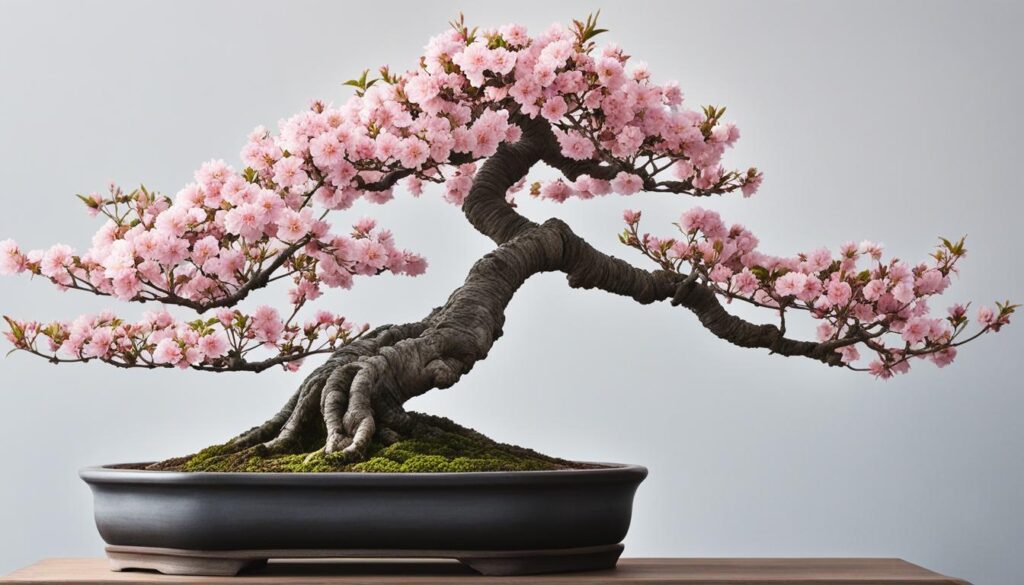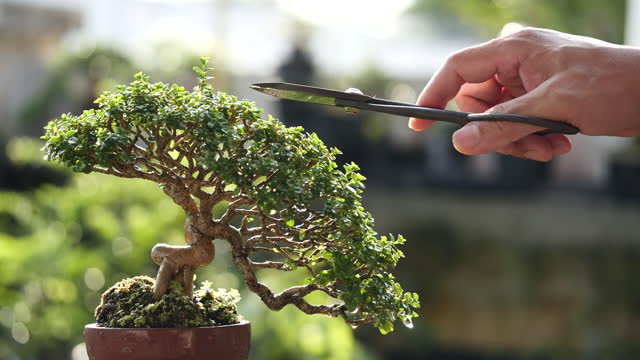If you’re captivated by the beauty of cherry blossoms and want to incorporate them into your own miniature garden, then cherry blossom bonsai trees are the perfect choice for you. These enchanting trees not only add a touch of elegance to any space but also provide a sense of tranquility and serenity.
One of the most alluring aspects of cherry blossom bonsai trees is their delicate and vibrant blooms. When properly cared for, these trees can transform your garden or indoor space into a breathtaking display of colors. From the classic pink hues of the Yoshino cherry variety to the stunning white petals of the Kanzan variety, there are numerous cherry blossom bonsai varieties to choose from, each with its own unique beauty.
But it’s not just about the aesthetics. Cherry blossom bonsai care goes beyond maintaining the visual appeal of these trees. It also involves nurturing their overall health and well-being. Proper watering, soil composition, pruning, and pest prevention are just a few of the important factors to consider when cultivating these miniature marvels.
In this guide, we will discuss the intricacies of cherry blossom bonsai care and provide you with valuable tips and insights. Whether you’re looking to purchase your first cherry blossom bonsai or have already embarked on your bonsai journey, our aim is to help you create and maintain vibrant and healthy cherry blossom bonsai trees that bloom with grace.
Understanding the Cherry Blossom Bonsai
In this section, we will discuss the enchanting world of cherry blossom bonsai trees and explore their captivating allure. From their deep-rooted significance in Japanese culture to the popular varieties used to capture the beauty of cherry blossoms in miniature form, cherry blossom bonsai trees are a true masterpiece of nature.
The Significance of Sakura in Japanese Culture
Sakura, the Japanese term for cherry blossoms, holds profound cultural significance in Japan. These delicate and ephemeral blooms represent the beauty and fragility of life, reminding us of its fleeting nature. The arrival of cherry blossoms in spring is celebrated nationwide through the centuries-old tradition of hanami or flower viewing. During this time, people gather under cherry blossom trees, enjoying the beauty of the blossoms and reflecting on the impermanence of life.
Popular Varieties for Capturing Cherry Blossom Beauty in Miniature
There are several popular cherry blossom varieties that are commonly used for bonsai, allowing enthusiasts to recreate the beauty of cherry blossoms in miniature form. Some of the most admired varieties include:
- Prunus serrulata: Also known as the Japanese cherry blossom or sakura tree, this variety boasts stunning pink and white blossoms, symbolizing renewal and the fleeting nature of life.
- Prunus incisa: Known as the Fuji cherry, this variety showcases delicate white blossoms and is cherished for its graceful and compact growth habit.
- Prunus subhirtella: Commonly referred to as the weeping cherry, this variety features cascading branches adorned with mesmerizing pink blossoms, creating a picturesque and serene ambiance.
Cherry Blossom Bonsai Ideal Placement and Sunlight Requirements
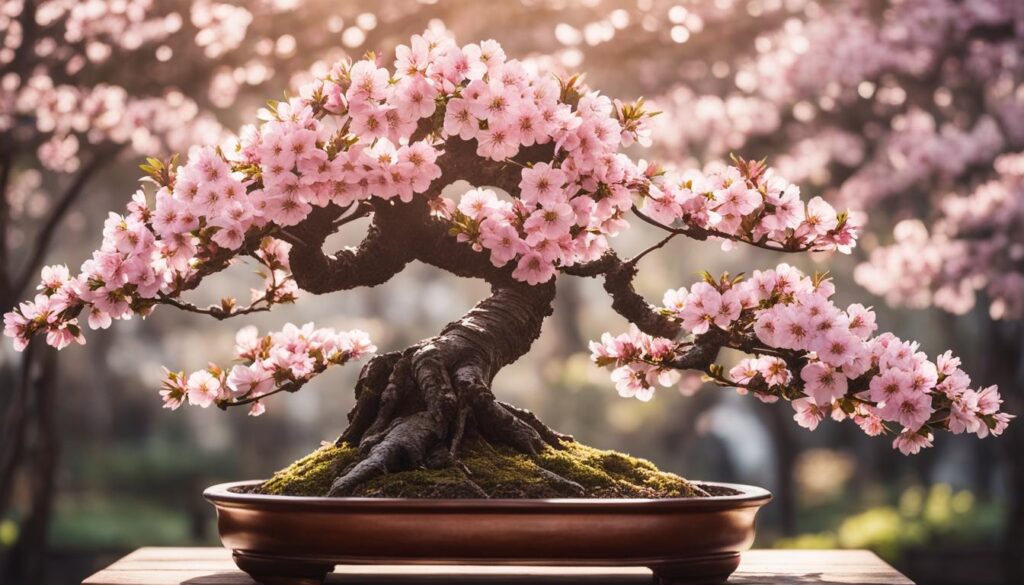
Proper placement and sunlight exposure are crucial for the optimal growth of cherry blossom bonsai trees. Understanding the ideal placement and sunlight requirements will help ensure that your cherry blossom bonsai thrives and produces vibrant blooms.
Do you know Cherry blossom bonsai can be grown on rocks as well? Click here to learn more
Sunlight Exposure for Optimal Growth
Cherry blossom bonsai trees require adequate sunlight exposure to thrive. The right amount of sunlight stimulates photosynthesis, which is crucial for the tree’s growth and overall health. Ideally, cherry blossom bonsai trees should be placed in an area that receives full sun for at least four to six hours a day. This direct exposure to sunlight will provide the necessary energy for the tree to develop strong branches and vibrant blooms.
When selecting a spot for your cherry blossom bonsai, consider placing it near a south-facing window or in an outdoor area that receives ample sunlight. If growing your bonsai indoors, ensure that the area provides sufficient natural light or consider using artificial grow lights to supplement the sunlight.
Finding the Balance Between Light and Shade
While cherry blossom bonsai trees require sunlight for optimal growth, finding the right balance between light and shade is also essential. Excessive exposure to intense sunlight can cause sunburn on the tree’s leaves and damage the delicate blossoms. To avoid this, it is crucial to provide some shade during the hottest parts of the day, especially during the summer months.
Avoid placing your cherry blossom bonsai tree in direct sunlight during the hottest hours, typically between 11 am and 3 pm. Instead, provide shade using a sheer curtain or place the bonsai under a tree that offers filtered sunlight. This will protect the tree from excessive heat and ensure its delicate blossoms remain intact.
By understanding the sunlight requirements and finding the right balance between light and shade, you can create an ideal environment for your cherry blossom bonsai tree to thrive. With proper placement and sunlight exposure, your bonsai will develop strong branches, lush foliage, and abundant blooms, allowing you to enjoy the enchanting beauty of cherry blossoms in miniature form.
Watering Tactics for a Thriving Cherry Blossom Bonsai
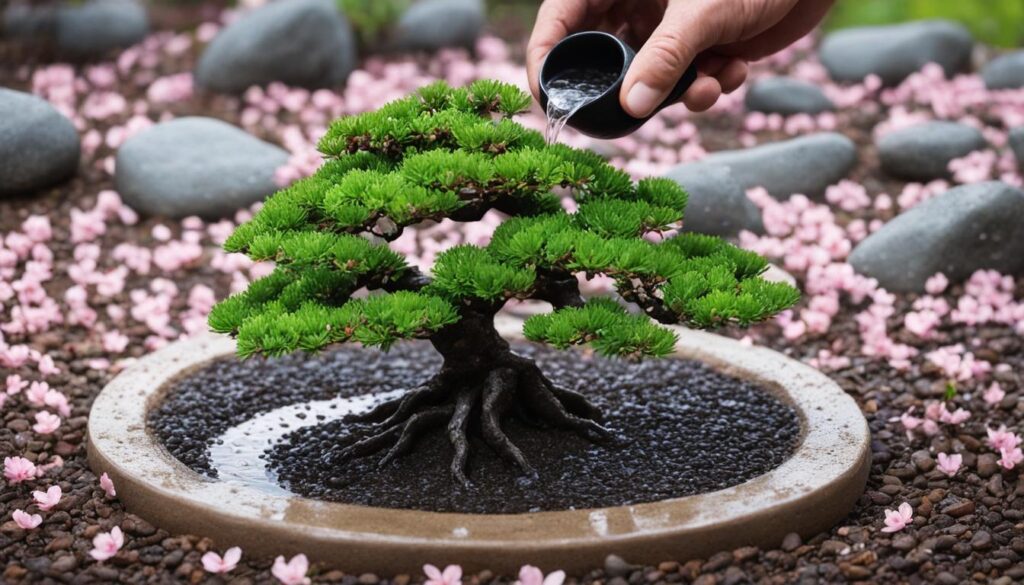
Proper watering is essential for maintaining the health and vitality of your cherry blossom bonsai trees. In this section, we will explore effective watering tactics that will help your bonsai thrive and produce beautiful blossoms. It’s crucial to strike the right balance between providing adequate moisture and avoiding overwatering, as both can negatively impact the health of your bonsai.
Maintaining Soil Moisture For Healthy Blossoms
The soil moisture level is a critical factor in promoting healthy blossoms in your cherry blossom bonsai. It’s important to understand that different stages of growth may require varying levels of moisture. Generally, you should aim to keep the soil consistently moist, but not soggy. Overly wet soil can lead to root rot and other issues, while excessively dry soil can stress the bonsai and impact its overall health.
To maintain appropriate soil moisture, consider the following tactics:
- Regular watering: Water your cherry blossom bonsai regularly, ensuring that the soil is evenly moist. Take care not to waterlog the soil, as it can deprive the roots of oxygen and promote rot.
- Monitor soil moisture: Use your finger or a moisture meter to check the moisture level of the soil. Insert your finger into the soil up to the second knuckle – if it feels slightly moist, it’s usually an indication that watering is not needed yet. If it feels dry, it’s time to water your bonsai.
- Watering frequency: Adjust the frequency of watering based on the specific needs of your cherry blossom bonsai. Factors such as temperature, humidity, and the bonsai’s location can affect how quickly the soil dries out. Monitor the soil regularly and water accordingly.
The Impact of Water Quality on Cherry Bonsai’s Health
The quality of water you use to irrigate your cherry blossom bonsai can significantly impact its health and overall growth. It’s important to be mindful of certain aspects when it comes to water quality:
- Use clean, non-chlorinated water: Chlorinated water can be harmful to the roots of your bonsai. It’s best to collect rainwater or use filtered water that is free from chemicals.
- Avoid hard water: Hard water is high in mineral content, which can lead to mineral buildup in the soil, affecting the pH balance and nutrient absorption. If you have no access to soft water, allow tap water to sit out overnight to allow some of the minerals to settle before watering.
- Avoid extreme temperature water: Using water that is too hot or too cold can shock the bonsai’s roots. Let tap water reach room temperature before using it on your cherry blossom bonsai.
By paying attention to soil moisture and water quality, you can provide the optimal conditions for your cherry blossom bonsai to thrive and produce stunning blossoms.
| Watering Tactics | Benefits |
|---|---|
| Regular watering | Ensures consistent soil moisture, promoting healthy growth and blossoms |
| Monitoring soil moisture | Prevents overwatering or underwatering, keeping the soil at an optimal moisture level |
| Watering frequency | Allows adjustment of watering based on environmental conditions and the specific needs of the bonsai |
The Fundamentals of Cherry Blossom Bonsai Soil
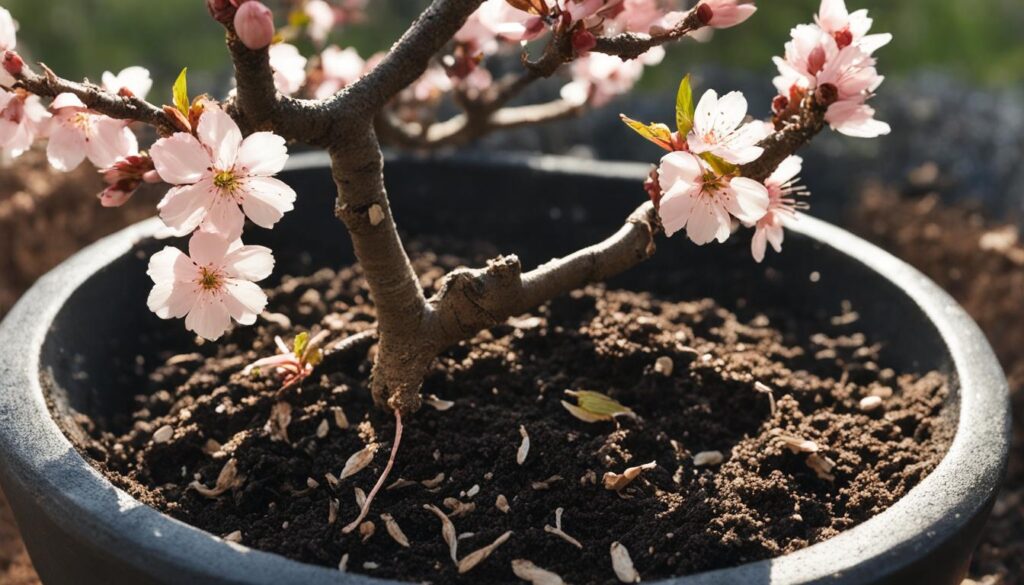
When it comes to growing healthy and vibrant cherry blossom bonsai trees, understanding the fundamentals of soil composition and pH levels is essential. The right soil provides the necessary nutrients and moisture for your bonsai to thrive and produce beautiful blossoms. In this section, we will explore the key factors you need to consider when it comes to cherry blossom bonsai soil.
Soil Composition and Drainage
The composition of the soil plays a crucial role in the overall health of your cherry blossom bonsai. The ideal soil should be well-draining to prevent waterlogging and ensure proper oxygenation of the roots. It should also retain enough moisture to keep the roots hydrated without becoming soggy. A balanced mix of organic matter, such as pine bark, peat moss, and perlite or pumice, provides the perfect soil structure for cherry blossom bonsai trees.
Organic matter improves the soil’s ability to retain moisture and nutrients while promoting healthy root development. The addition of inorganic particles, like perlite or pumice, aids in creating air pockets within the soil, enhancing drainage and preventing compaction.
Learn more about best Bonsai Soil: Best Bonsai Soil: Top Mixes Reviewed
pH Levels: Ensuring the Right Acidity for Cherry Blossom
The pH level of the soil is another essential factor in cherry blossom bonsai care. The ideal pH range for cherry blossom bonsai is slightly acidic, between 5.5 and 6.5. This acidity level provides the optimal environment for the roots to absorb nutrients effectively.
To determine the pH level of your soil, you can use a soil testing kit or consult with a professional. If the pH is too low (acidic), you can raise it by adding powdered limestone to the soil. On the other hand, if the pH is too high (alkaline), you can lower it by incorporating organic matter, such as pine needles or compost. Regular monitoring and adjustment of the soil pH will help maintain a balanced and healthy growing environment for your cherry blossom bonsai.
Now that you understand the fundamentals of cherry blossom bonsai soil, you can create the ideal growing conditions for your bonsai tree. The right soil composition and pH levels will contribute to the overall health and beauty of your cherry blossom bonsai, ensuring vigorous growth and abundant blooms.
Mastering the Art of Pruning Cherry Blossom Bonsai
Pruning is a fundamental aspect of bonsai care, and mastering the art of pruning is essential for shaping and maintaining the aesthetics of cherry blossom bonsai trees. By implementing proper pruning techniques, you can create beautiful and well-maintained cherry blossom bonsai trees that exhibit the unique charm of these exquisite plants.
When it comes to pruning cherry blossom bonsai, timing is crucial. The ideal time for pruning is during the dormant season, typically in late winter or early spring, before the tree starts to actively grow. Pruning during this time allows you to shape the tree and encourage new growth in the desired direction.
One of the primary pruning techniques for cherry blossom bonsai is selective pruning. This involves carefully removing specific branches and shoots to enhance the overall shape and balance of the tree. By selectively pruning branches that are growing in unwanted directions or crossing over each other, you can create a harmonious and visually appealing bonsai.
Pro Tip: When pruning cherry blossom bonsai, always use sharp and sterile pruning tools to minimize the risk of introducing infections or diseases. It’s also essential to have a clear vision of the desired shape and plan the pruning cuts accordingly.
In addition to selective pruning, it’s crucial to practice proper pruning techniques such as branch reduction, branch thinning, and bud pruning. Branch reduction involves shortening long branches to maintain the tree’s proportions and prevent them from overshadowing other parts of the bonsai. Branch thinning helps improve airflow and light penetration within the tree, promoting healthy growth and preventing diseases.
Another important aspect of pruning cherry blossom bonsai is bud pruning. This technique involves removing unwanted buds to direct the tree’s energy towards desired areas, such as promoting the growth of new branches or redirecting growth to specific regions of the tree.
Remember that each bonsai tree is unique and requires a customized pruning approach based on its growth pattern and aesthetic goals. Regular pruning sessions throughout the year can help maintain the desired shape and size of your cherry blossom bonsai.
By mastering the art of pruning and understanding the specific pruning techniques for cherry blossom bonsai, you can create stunning bonsai trees that capture the essence and beauty of these delicate blossoms. Pruning allows you to shape and sculpt your bonsai, while also promoting healthy growth and enhancing the overall aesthetics of your cherry blossom bonsai.
Cherry Blossom Bonsai Fertilization Strategies
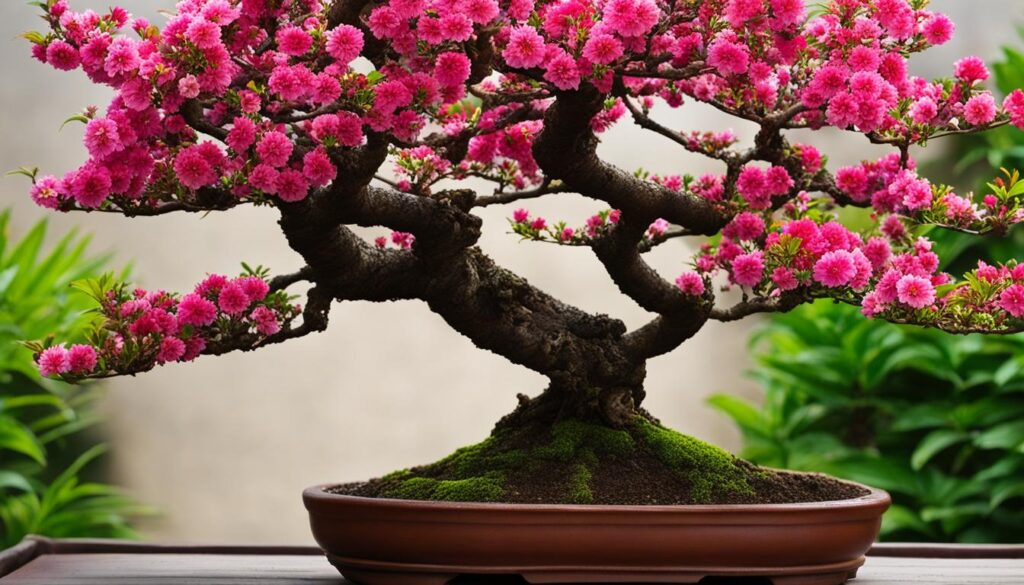
Fertilization is a crucial aspect of cherry blossom bonsai care that directly impacts the overall health and growth of your trees. By implementing effective fertilization strategies, you can promote vigorous growth and vibrant blooms in your cherry blossom bonsai trees.
When it comes to fertilizing your cherry blossom bonsai, it’s essential to choose the right type of fertilizer that provides the necessary nutrients for optimal growth. Look for a balanced fertilizer specifically formulated for bonsai, which contains essential elements like nitrogen (N), phosphorus (P), and potassium (K).
It’s recommended to apply fertilizer during the growing season of spring and summer, when your cherry blossom bonsai is actively producing new foliage and blooms. Start fertilizing once the tree has fully leafed out and continue every two to four weeks, following the package instructions for the recommended dosage.
While fertilizing your cherry blossom bonsai, it’s crucial to maintain a balance and avoid over-fertilization. Too much fertilizer can lead to excessive growth and weak branches, making your bonsai more susceptible to pests and diseases. Therefore, it’s essential to carefully measure and apply the recommended amount of fertilizer.
Another key factor in fertilization is balanced nutrition. Your cherry blossom bonsai requires a combination of macro and micronutrients for healthy growth. In addition to the NPK elements, it’s beneficial to include trace elements like iron (Fe), manganese (Mn), and zinc (Zn) in your fertilizer. These micronutrients play a vital role in maintaining optimal health and promoting vibrant blooms.
To ensure that your cherry blossom bonsai receives a balanced diet, you can consider using slow-release fertilizers or organic options like fish emulsion or seaweed extract. These natural fertilizers not only provide essential nutrients but also improve the overall soil fertility.
Remember to monitor the growth and health of your cherry blossom bonsai closely. If you notice any signs of nutrient deficiency or excessive growth, adjust your fertilization strategy accordingly. Regularly inspecting your bonsai and making necessary adjustments will help maintain a healthy and thriving cherry blossom bonsai tree.
How to Repot Cherry Blossom Bonsai Trees
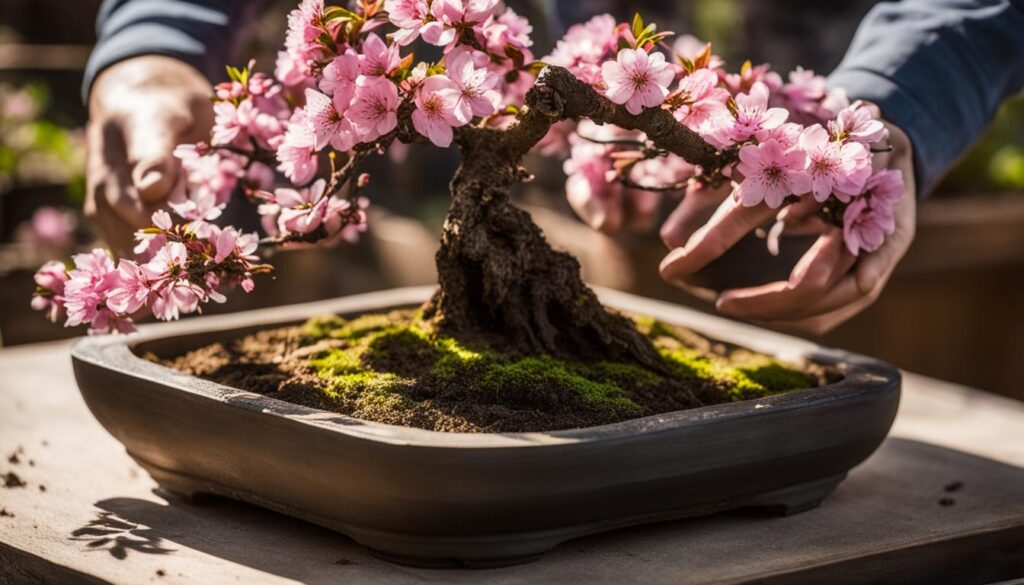
Repotting is an essential aspect of bonsai care, ensuring the long-term health and vitality of your cherry blossom bonsai trees. By understanding the repotting process and following these key tips, you can provide the best environment for your bonsai to thrive.
When to Repot: Cherry blossom bonsai trees should be repotted every 2-3 years to prevent root congestion and maintain optimal growth. The best time to repot is during the dormant season in early spring or late winter, just before buds start to swell.
How to Repot: Follow these steps for successful cherry blossom bonsai repotting:
- Carefully remove the tree from its current pot. To do this, use a root hook or chopstick to loosen the roots from the pot’s edges and gently lift the tree out.
- Inspect the roots and prune them if necessary. Trim any damaged or overgrown roots, ensuring to retain the tree’s original structure.
- Select a new pot with adequate drainage holes. The new pot should be slightly larger than the previous one, allowing room for growth.
- Prepare the new pot by covering the drainage holes with mesh or screen to prevent soil from escaping.
- Place a layer of fresh bonsai soil in the bottom of the pot.
- Position the tree in the new pot, ensuring that it sits upright and centered.
- Fill the remaining space around the roots with bonsai soil, gently firming it in place to eliminate air pockets.
- Water the repotted tree thoroughly to settle the soil and hydrate the roots.
The Right Pot and Soil: Choose a pot that complements the size and style of your cherry blossom bonsai. Opt for a pot made of ceramic or clay, as these materials provide stability and help regulate moisture levels. When it comes to soil, use well-draining bonsai soil or a mix of Akadama, pumice, and lava rock for optimal water retention and aeration.
Aftercare: After repotting, place your cherry blossom bonsai in a shaded area to recover for a few weeks. Avoid direct sunlight and excessive watering during this period. Gradually reintroduce your bonsai to its regular care routine, including proper watering, sunlight exposure, and fertilization.
By following these repotting tips, you can ensure that your cherry blossom bonsai trees have ample space for root growth, allowing them to thrive and beautify your space for years to come.
Pest and Disease Prevention in Cherry Blossom Bonsai Care
Maintaining the health and vitality of your cherry blossom bonsai trees requires effective pest and disease prevention. By implementing the following techniques, you can keep these threats at bay and ensure the longevity of your cherished bonsai.
1) Regular Inspection: To prevent pest infestations and identify potential disease issues, it is essential to inspect your cherry blossom bonsai regularly. Carefully examine the leaves, branches, and trunk for any signs of pests or infections. Early detection is key to prompt treatment.
2) Proper Sanitation: Keeping your bonsai environment clean is crucial in preventing the spread of pests and diseases. Remove any fallen leaves or debris that may harbor harmful organisms. Additionally, sterilize your tools, such as pruners and scissors, before and after each use to minimize the risk of contamination.
3) Adequate Air Circulation: Providing sufficient airflow around your cherry blossom bonsai helps prevent the buildup of humidity, which can contribute to disease development. Avoid placing your bonsai in areas with stagnant air or overcrowding it with other plants.
4) Selecting Resistant Varieties: Some cherry blossom bonsai varieties are naturally more resistant to pests and diseases. Prioritize these resistant varieties when selecting new bonsai trees to add to your collection. Researching and choosing the right varieties can significantly reduce the risk of infestations and infections.
5) Organic Pest Control: Consider using organic pest control methods, such as neem oil or insecticidal soap, to combat common pests like aphids or spider mites. These natural options are less harmful to the environment and can effectively manage pest populations without endangering your bonsai’s health.
6) Consultation with Experts: If you encounter persistent pest or disease issues despite your prevention efforts, don’t hesitate to seek advice from bonsai experts or horticulturists. They can provide valuable insights and recommend specific treatments tailored to your cherry blossom bonsai’s needs.
By incorporating these pest and disease prevention techniques into your cherry blossom bonsai care routine, you can safeguard your trees from harm and enjoy their beauty for years to come.

